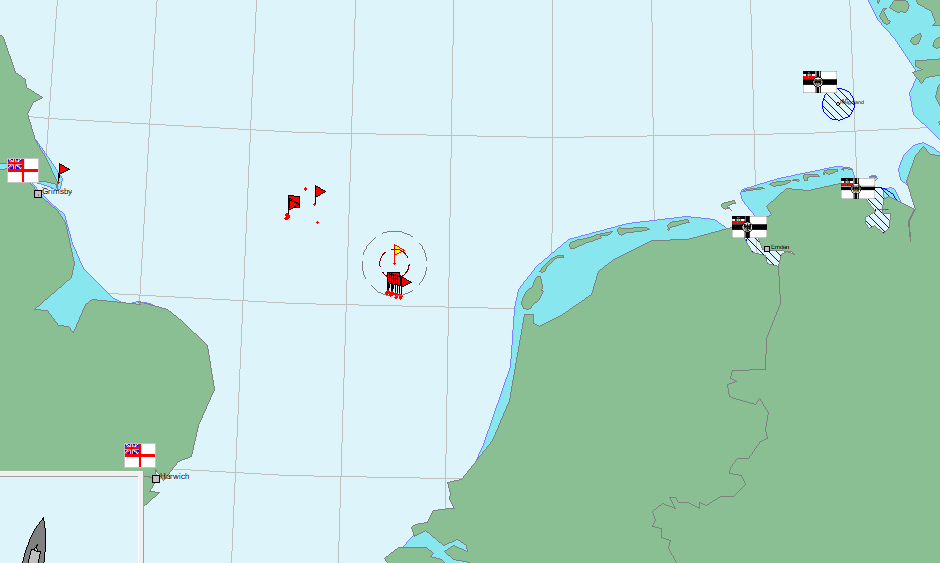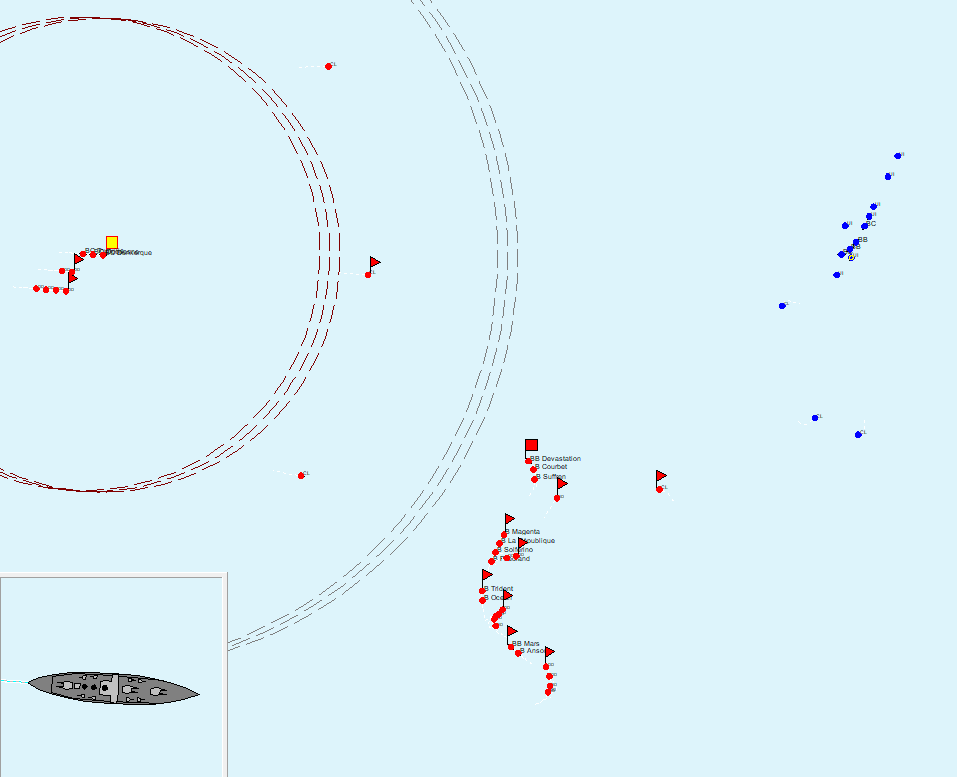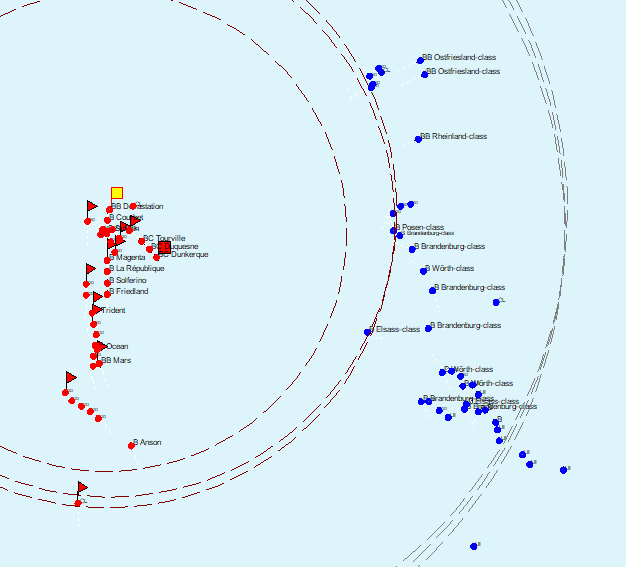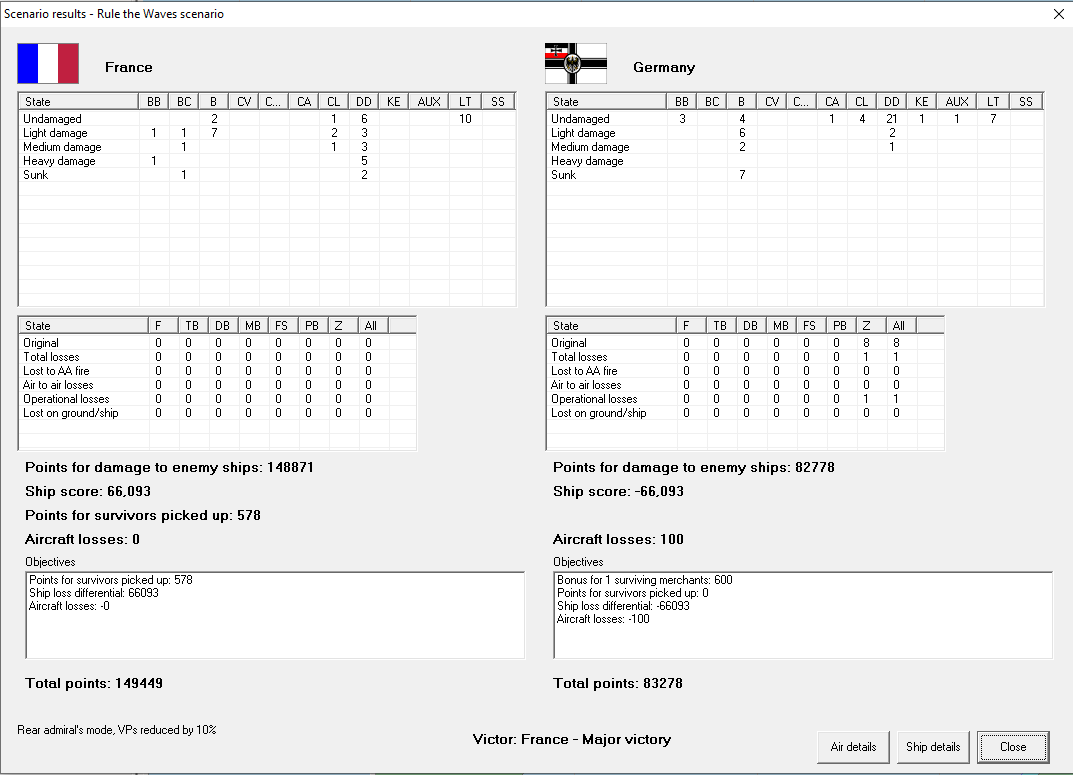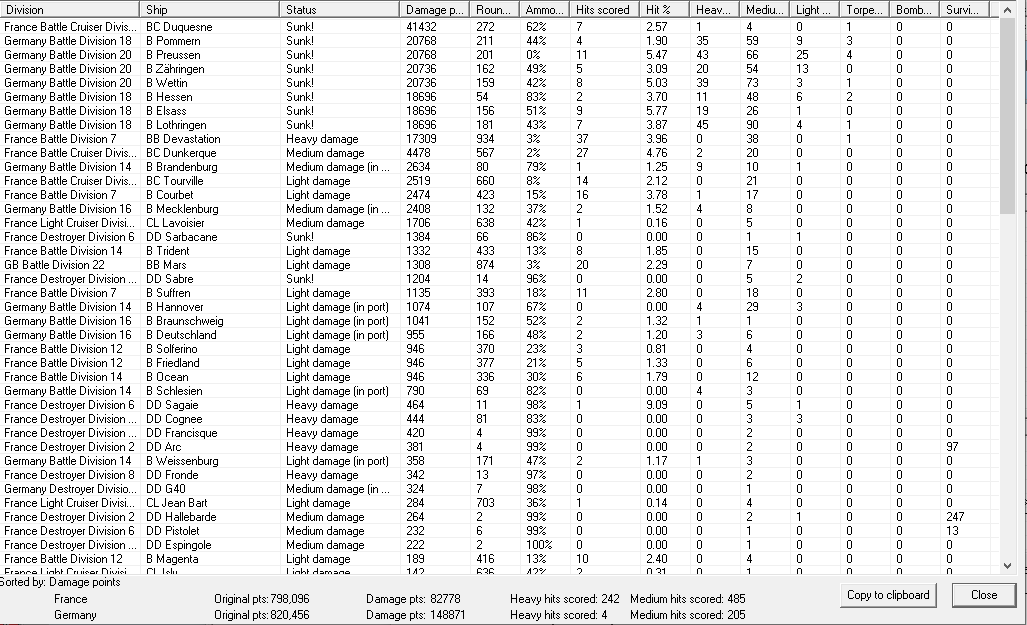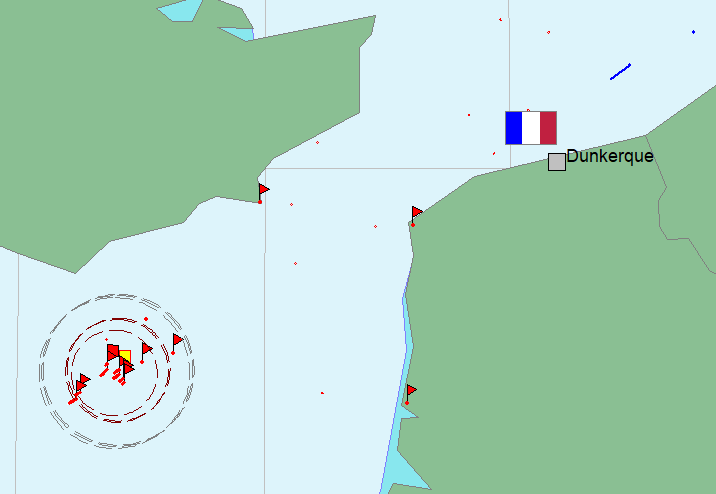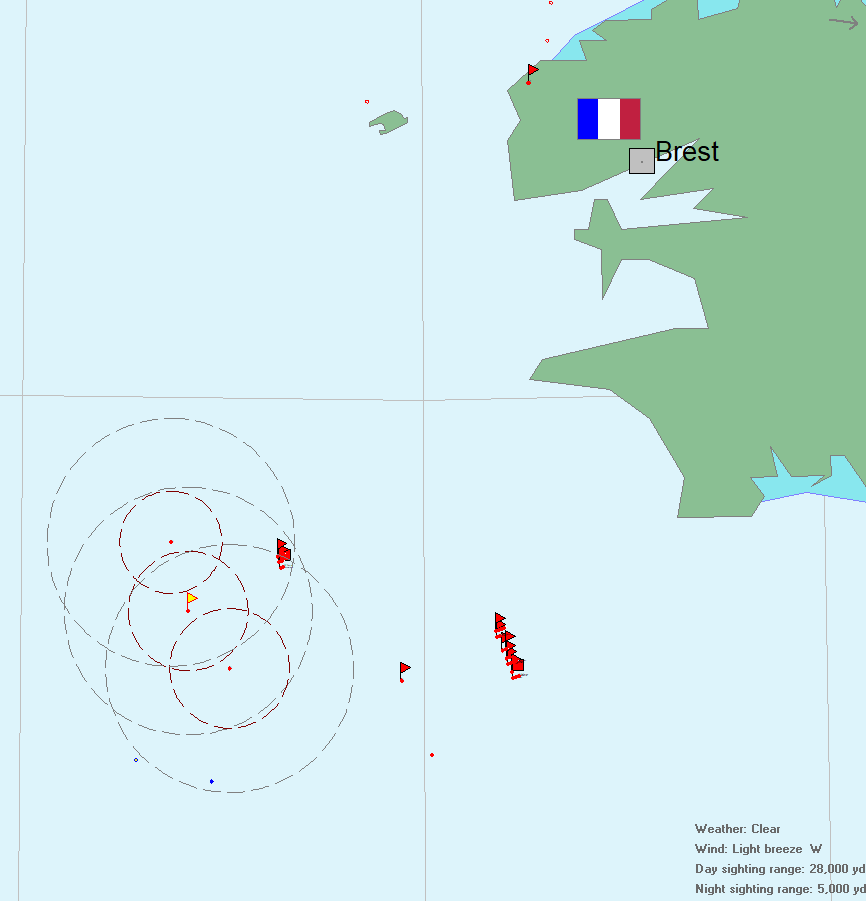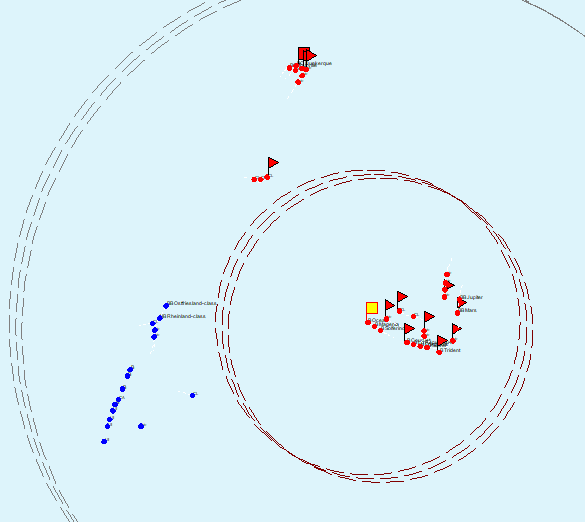I agree with rho21, and attack commerce with BCs and other raiders. If somehow the British deal a solid blow to the German main fleet, then you could re-concentrate and potentially seek a fight.
I wonder if you can risk a fleet battle, just to avoid victory point hits. You are likely to have British support in a fleet battle, and your modern ships are better than their modern ships, and your older ships are faster than their older ships.
So the British might bring you closer to parity in the fight, and if that’s not the case, you stand a good chance of manuevering to avoid engaging their old ships (or catch them badly positioned with BBs or BCs). Some of those battleships could sink rather quickly to more modern guns.
If you can win a fleet battle, you might be able to break the blockade. Plus fighting a fleet battle is fun!
March 1912
A good start to our campaign of trade warfare: our raiders sank six German merchants and one submarine.
A British light cruiser, the Phaeton, an obsolete 21-knot light cruiser, joins Lavoisier and Isly for a cruiser battle off of Bergen. It’s 11:37 a.m., and the weather is good but windy.
Unfortunately, the German cruisers show up and the French battlecruisers do not, so the French admiral bravely turns his ship to starboard and runs for the safety of Scapa Flow. Phaeton gives it her best, but the two 24-knot German cruisers are on hand, and she isn’t fast enough to escape.
April 1912
Here it is. The big one.
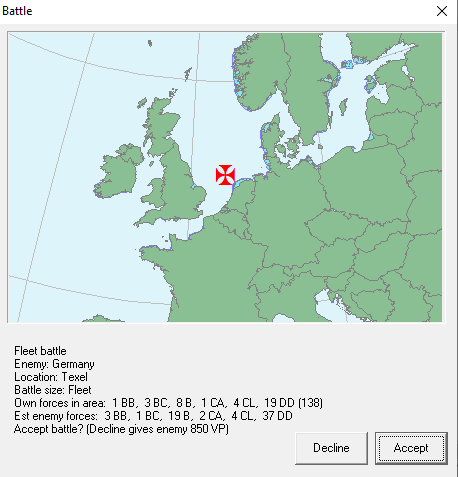
The Battle of Texel
Today’s forces include the full French fleet: three battlecruisers, one battleship, our entire predreadnought force, and a smattering of light cruisers and destroyers. Joining us are one British dreadnought, the Mars, and Anson, an 18-knot predreadnought, along with their escorting destroyers.
This is the first battle in which our scouting force (the battlecruisers and the three Isly-class light cruisers) are operating separately.
The weather is good, and it’s just after dawn. Let’s see what comes of the day.
5:37 a.m.
Linois, the sole light cruiser scouting for the main fleet today, spots a light cruiser to the north. It immediately turns northwest, which puts it on a collision course with the battlecruiser force.
6:03 a.m.
The enemy light cruiser turns due east.
6:21 a.m.
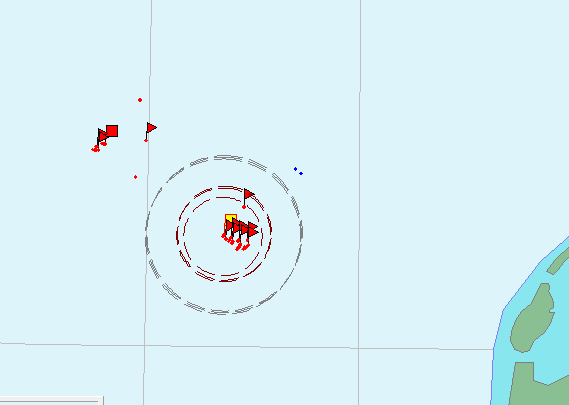
Linois spots another ship, as the battlecruisers race east.
6:53 a.m.
The enemy’s battle line comes into slight.
7:08 a.m.
As the lines converge, our Courbet is the first to take a hit—a harmless one to the superstructure.
The lead divisions are now engaged—Devastation firing eight-gun broadsides at the German Ostfriesland, the super-pre-dreadnought from last time, leading the way.
7:23 a.m.
The battlecruisers slot into the battle line just ahead of the lead battle division. The Ostfrieslands leading the German line turn away, although it may just be to open the range. (Their guns reach further than ours do.)
7:44 a.m.
For once, the gunnery duel in the early going is favoring the good guys—four hits to one.
8:00 a.m.
The front of the German line has turned north-northeast, so in the hopes of catching the back of the German line unawares, I order a near-180-degree turn, so that while the Germans are heading north, we’ll be heading south.
8:20 a.m.
I am content to call that a smart move. The German super-pre-dreadnoughts have disappeared off to the northeast, and the Allied line is in good order while the German battleships are entirely out of sorts.
8:59 a.m.

The Germans are attempting to retire from the field. Several of their predreadnoughts are heavily damaged. I expect we’ll be able to finish them off. After all, we still have… nine hours and fifty minutes before dusk.
9:26 a.m.
Duquesne takes a torpedo hit and falls out of line.
10:01 a.m.
Duquesne’s torpedo hit proves fatal, but we get revenge for her with a torpedo to one of the Elsass-class pre-dreadnoughts still engaged.
11:00 a.m.
A glorious victory is in progress. While the German fleet ran, we managed to peel off six predreadnoughts, which we are currently hammering with a superior force.
Results
Seven predreadnoughts down, for the price of one battlecruiser (to be replaced next month; Lyon was delayed again) and two destroyers (cheap and easy to rebuild, although the question of when is a harder one).
Torpedoes proved critical on both sides, sinking Duquesne and contributing heavily to the sinkings of a number of German battleships.
In the after-action map, you can see the critical elements of the battle: the turn to the north to parallel the German battle line, the reversal south which permitted the German super-pre-dreadnoughts to escape but allowed us to finish off a large number of the pre-dreadnoughts, and the long mop-up to the east-northeast.
The game calls it a minor French victory, on the basis that we lost a battlecruiser. I say it’s better than a mere minor victory.
May 1912
Lyon, designed as a 25-knot battlecruiser, has difficulty making her design speed in trials. She’ll go into the books as a 24-knot battlecruiser instead. I should have liked her to be a bit faster.
To replace her on the ways, the new Requin class goes into development. On the (admittedly German) theory that the first duty of a warship is to stay afloat, she retains a 12" armament (our quality-0 12" guns served us in good stead in the last fleet battle, and twelve of them helps with the smaller shell). Her 22-knot speed suffices for our current battle line (lacking oil, high speed is hard for us right now), and her 14" belt is more than enough to stop shells from the guns we’re likely to face.
French raiders have a successful month, sinking eleven German merchants.
June 1912
On the 23rd, coastwatchers detect a German raid approaching Calais. Nine battleships and two battlecruisers put to sea in response: Devastation (our sole dreadnought, currently); Courbet (one of our two Trident semi-dreadnoughts); Ocean, Solferino, La République, Magenta (four predreadnoughts); Tourville and Dunkerque (the surviving Duquesne-class ships); and a surprise appearance from Mars, Jupiter, and Majestic, three British dreadnoughts.
The weather is breezy and overcast, but patrol boats and coastal lookouts indicate that a) the German force is quite small, and b) it’s headed directly for the narrowest part of the Channel.
The dot in the northeast portion of the map is an old sighting report. The line is the freshest report, along with an indication of where the enemy is, provided the sighting report’s course and speed were correct.
It’s relatively early in the morning, and being so close to the solstice means we’ll have ample time to defeat the Germans if we can trap them.
At 10:44 a.m., leading elemnents of the Scouting Force sight German ships.
By 11, it’s clear that a decent porton of the German fleet is out to play, but crucially, not all of it. I don’t think we’re going to catch the modern German ships (Ostfriesland and Rhineland, two of the super-pre-dreadnoughts), but we might end the careers of a few more German predreadnoughts if we’re lucky.
In the final reckoning, the French Navy bags all three of the predreadnoughts on the field.
A glorious victory. As an added bonus, it breaks the German blockade.
July 1912
In technological news, we’ve unlocked destroyers of up to 1100 tons. Perhaps a new design to replace some of those we’ve lost?
The battle this month is another fleet battle, a few dozen miles west-southwest of Brest.
Devastation is in the yards, undergoing repairs from so facing the German forces in the area are our two Duquesne-class battlecruisers (regrettably, Lyon has not finished her working up), our eight pre-dreadnought battleships, and two British dreadnoughts (Jupiter, an obsolete 6-gun/18-knot model, and Mars, a 10-gun/22-knot model which has played a starring role in multiple battles so far.)
Facing us are (probably) the two German super-pre-dreadnoughts, the remaining nine standard pre-dreadnoughts, and some light units. I’d say we have slightly better than even strength, and we’re notably well-positioned this time. We have the shorter path back to the Channel, where the German fleet would probably prefer to run, we’re downwind of them (so our smoke will blow away and theirs will get in their way), and our battlecruisers are to the north of the Germans.
With the scouting force in advance of the main fleet and light cruisers spread out in a search line, La Royale occupies quite a lot of ocean.
12:45 p.m.
That’s the only downside—we’re into the afternoon. Seven hours until dusk isn’t a ton, but hopefully it’ll be enough.
12:55 p.m.
The scouting force catches sight of the enemy battle line. We should be able to cut them off with time to spare.
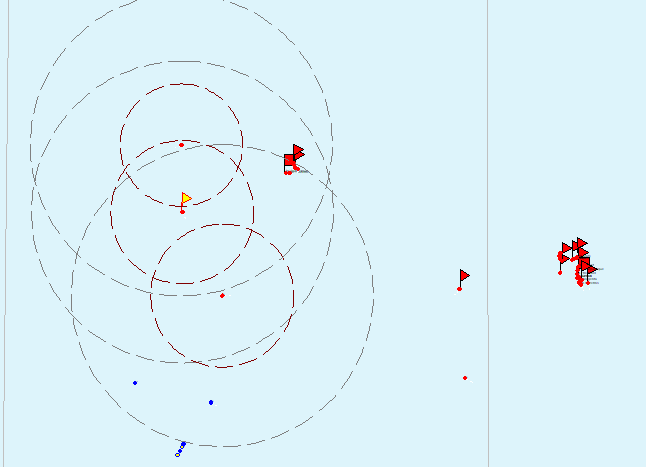
14:04 p.m.
A near-textbook approach completed, the fleet closes to range and prepares to turn in line with the enemy.
15:45 p.m.
The German heavy units make it away, but it’s entirely possible we’ll sink most of the German Navy’s remaining pre-dreadnought fleet today.
Results
Night falls on another dramatic French victory. At the cost of one pre-dreadnought and a few destroyers, we sank seven German pre-dreadnoughts.
Tourville and Dunkerque, gunnery champions in the preceding battle by a country mile, are joined by Lyon in the aftermath, whose 15" guns will give the battlecruiser squadron unprecedented reach and striking power.
July 1912, cont’d.
On the basis that the German fleet is now, in large part, at the bottom of the Atlantic, I’m planning on sending the battlecruisers to the Mediterranean once they’ve been patched up, where they can begin to whittle down the German cruiser force, which is largely deployed there. Britain’s contributions to the war effort have been most satisfactory in Northern Europe, so between our battleships and theirs I suspect we can keep the Germans bottled up.
In terms of war goals, I don’t have designs on many of the German colonies, which are all outside of our invasion range anyway. My primary objective is to impose debilitating reparations (which has never backfired for France re: Germany), with which I can continue to modernize the fleet even on a low-tension, peacetime budget.
August 1912
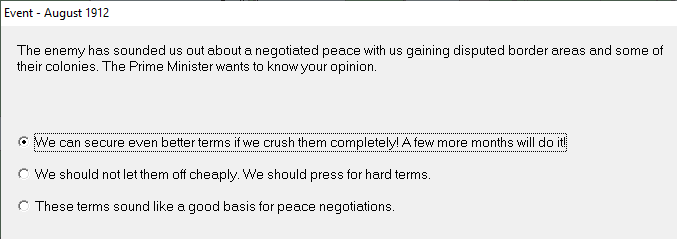
I feel justified in picking this option.
Of course, just after delivering that ultimatum, we lose the Lavoisier (second of her name) to a magazine explosion in a light cruiser action off of St. Nazaire. This calls for a new class.
September 1912
A cruiser action in the Bay of Biscay sees Dunkerque, left behind in Northern Europe to finish repairs while her sisters sailed for Marseilles, send two German light cruisers to the bottom, a fitting revenge for Lavoisier.
December 1912
A few boring months end with an extraordinary victory.
I feel a little bad about not taking screenshots during the battle, but really, it wasn’t very exciting. The British indicated that a German convoy was on its way from Norway to Germany proper, carrying iron ore. The French fleet sortied, joined by a pair of British dreadnoughts, and, crucially, a flotilla of British destroyers. Rather than flee and let the convoy be destroyed utterly without a fight, the three German super-pre-dreadnoughts turned to close the range and bring their large secondary batteries to bear, at which point accurate torpedo work by the British destroyers slowed them to the point where we could overwhelm them with volume of fire.
There were some interesting bits of cruiser action off to the north of the main battle, where French ships darted in toward the convoy while Germans shuffled east and west to fend them off.
The game keeps track of your glorious victories, and proposes names. In terms of strategic decisiveness, I feel like this fits, even if it was a) a little smaller than the historical one, and b) much more tactically decisive.

January 1913

Intel has some juicy news. The German ships must be very fast indeed, because our battlecruisers are just about even with theirs, and substantially lighter.
Wrap-Up
After one year of war, the combined might of the Allied navies has utterly swept the Germans from command of the sea. They have no dreadnoughts, battlecruisers, or battleships of any kind afloat. The German heavy cruiser force has been a non-factor in the war so far; much of it is currently in the Mediterranean, cut off from its bases.
French naval superiority is about to get even bigger—in two months, Redoubtable will be in service, followed five months later by Marengo. Four new destroyers will join the fleet around the same time to fill in for losses; two new light cruisers are under construction and due in about a year and a half.
The victory point totals are extremely favorable to us: 40,340 to 14,843. We have, understandably, gained somewhat in prestige as well: up to 29, our peak so far. When the war ends, I’m not much inclined to push for colonies. Germany doesn’t have very many good ones, having started the race when the leaders were already halfway through, and reparations will help us keep building ships when the postwar budget crunch comes.
To replace the two new dreadnoughts coming soon, I have it in mind to start another next-generation Requin-class dreadnought, and to design a cost-controlled battlecruiser—something with 9 12" guns, 12" armor, and 27-knot speed is well within reason.
I’m going to cut this update short here—covering two years of war in great detail, especially if it’s this eventful, is tricky.
Your thoughts on strategy, planning, and shipbuilding welcome.
I’m glad you went with the more aggressive approach. It seems to have worked out well!
In economic terms, the coming reparations will hurt the Germans a lot. The actual loss of their ships is probably less significant, since they would all be retired anyway by the time the next war rolls around.
You will probably want to put your old pre-dreadnoughts out to pasture soon after this war ends as well. You don’t want to be in the situation of paying to keep relics afloat while the germans build all new stuff.
A few questions
-
What does winning that war gain you besides prestige points? Germany will pay you reparations in the form of money?
-
How much of your great victory was (possibly weak) game AI? Germany seemed at least your equal yet you hammered them.
A few observations
- The British helped far more than expected.
- Torpedoes seem to be pretty effective
Agree on sweeping the Med. Should be easy pickings
Agree on getting some updated replacement DD’s in the build plan.
Not sure on the idea of developing a cost controlled BC. Doesn’t that cost extra to design/trial a new class vs just building your current designs?
Money or territory, with more of one yielding less of the other.
Some, maybe? A lot of my success stemmed from the German habit of running away with a superior force, but there was an awful lot of that during the real Great War. In particular, Jellicoe caught a lot of flak after Jutland for not pursuing the High Seas Fleet more vigorously. British admirals turned away from a lot of fights for fear of torpedoes.
Indeed! Tripling our quadrupling our dreadnought strength on several occasions, they have proven themselves to be invaluable allies. I’ll be hoping to keep that relationship going forward.
La Jeune École would agree.
A new ship design costs about 4,000 funds. The savings on a budget design (say, 2,600 funds per month vs. 3,000 funds per month) over a dreadnought’s build time (about 30 months) would be about 12,000.
So the way I understand it, the reparations would go into the French general economy, not into the French naval budget directly. The naval budget is a fraction of the nation’s economy, with the percentage going up and down depending events and wars, etc.
The nation’s economy grows at a certain percentage rate over time (with some nations like the US and Germany getting more growth than others). I think the reparations amount adds to the receiving nation’s base amount, which gets amplified over time due to economic growth.
It seems like a slightly strange way of doing it, but I have read that players who get a lot of reparations across multiple wars can really end up with a much stronger economy even decades later.
Why did you fight this one out, so aggressively, when you were outnumbered? Did you figure your BC was equivalent to their BB? Or were you confident in your ability over the AI? (It worked out, clearly.)
Our full battle line was faster than their full battle line, and the parts of their battle line fast enough to stay with our line was weaker than ours. If the German fleet had hammered us badly on the run north, or stayed in good order after the 8:00 a.m. turn south, I would have put the helm over and run for a port on the English coast.
Ah, makes sense. I guess you knew this from all the intel that had been gathering pre-war?
In this allied engagement, do you control the English ships or are they AI-controlled?
Sorry for the unannounced skip last week—I had a lot to do and a small amount of time to do it.
Also, I left two questions unanswered, so before I dive in…
Yes, between the game’s intelligence spending sliders and just looking through the enemy ship listings in the almanac.
In all the engagements in this war, they’ve been under my command. I’m not sure if it ever happens with AI-controlled allies. In certain kinds of battles, there are AI-controlled friendly forces, so it seems at least possible.
January 1913
With no serious objections raised against the idea, I come up with the (slightly) budget-minded Rouen-class battlecruiser.
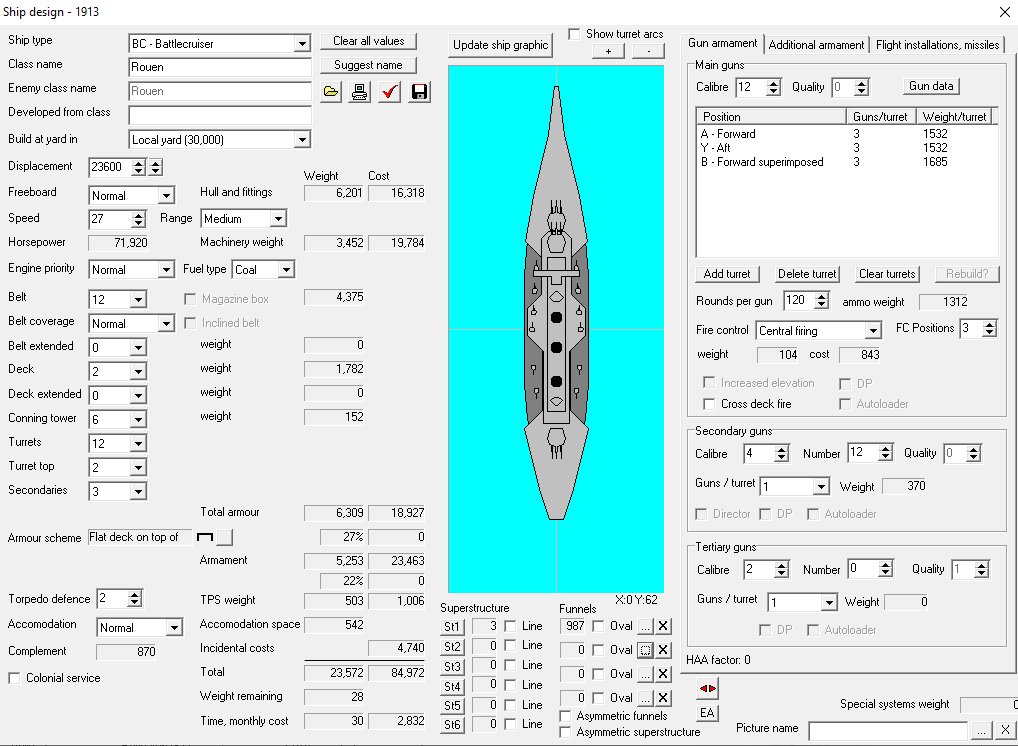
27-knot speed will make her one of the fastest heavy ships afloat, and 9 12" guns mean she won’t lack for punch.
February 1913
The battle of the month is a coastal raid in the North Sea. Combined French and British forces scour the seas for German merchants, sinking one along with an escorting corvette, but come across no other foes.
March 1913
In unfortunate news, our Redoubtable-class battleships have trouble hitting their design speed. Happily, that design speed was 23 knots instead of 22, so they’re still as fast as the rest of our battle line.
The battle of the month is an enemy raid on our shipping.
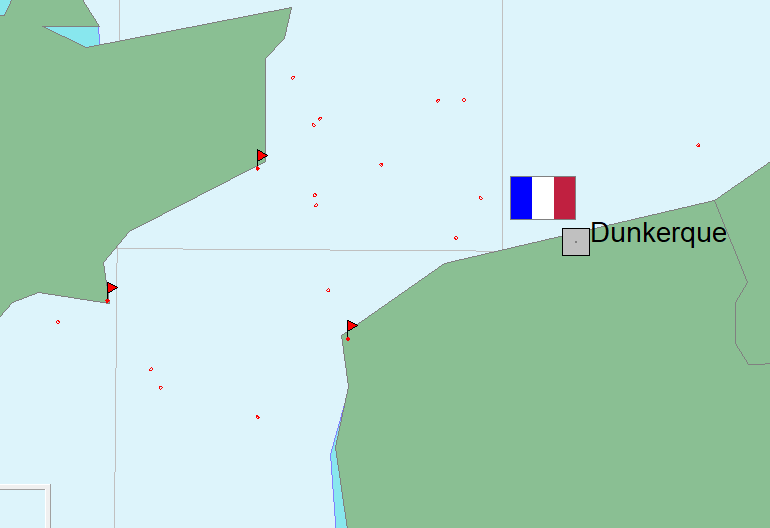
The English Channel is a dangerous place to be if you aren’t English or French—heavy minefields protect the narrows. (The little red dots indicate mined areas. This is what the large blue circles around German ports, if I’ve taken a picture of them, would have looked like to a hypothetical German player.)
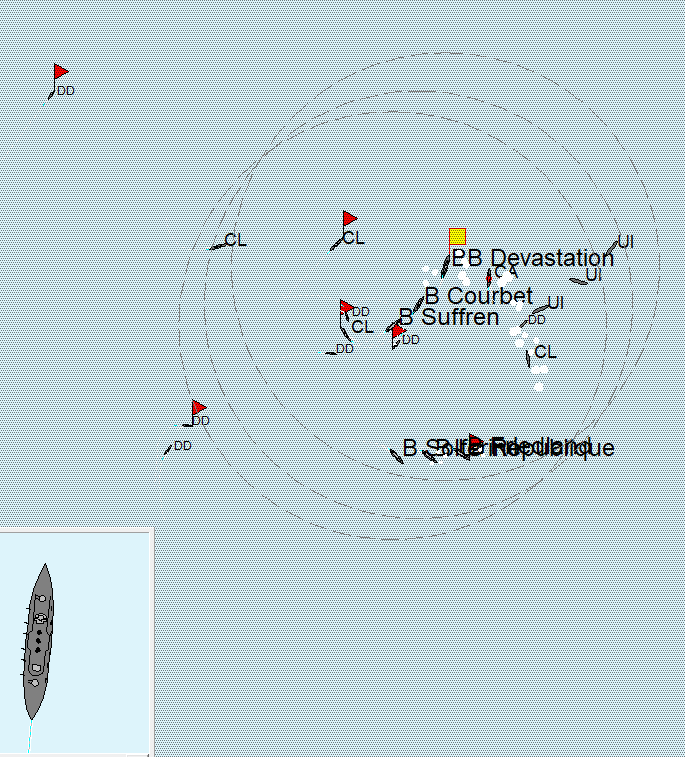
It turns into a knife-fight just after dusk, which is a bad situation for us. Our superiority is assured; there’s no reason to waste our big ships on fights where torpedoes can sink them too readily. (The big advantage of the upcoming R-class battleships and battlecruisers is that they ship torpedo protection, armor against the devilishly-powerful underwater weapons.)
Reluctantly, like Jellicoe at Jutland, we turn away. Perhaps we’ll be able to catch up to that damaged armored cruiser in the bottom left of the screenshot later.

Or not! That neatly solves that problem.
Suffren eats a torpedo despite our evasion, but doesn’t seem critically damaged.
The French fleet pursues the fleeing Germans north through the night, but doesn’t find them in the morning, and so turns back to Dunkerque.
April 1913
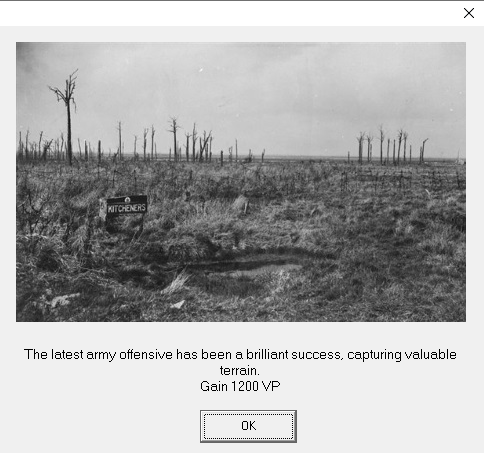
Our brothers in arms do a thing!
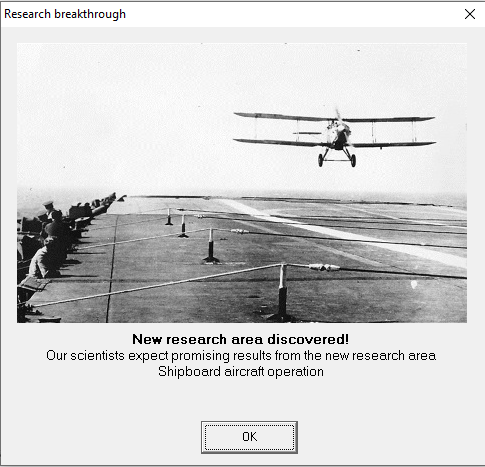
Picture two French naval engineers at a Paris cafe, a bottle of wine between them, cigarettes propped on the ashtray, smoke twisting lazily toward the darkening sky: “I wonder if zis will ever catch on.”
The battle of the month is a convoy defense in the Bay of Biscay. Three Allied light cruisers face two Germans, sinking one of them.
May 1913
The Germans win a cruiser action, sinking the old Tage-class light cruiser Surcouf with a torpedo.
June 1913
The Germans win another light cruiser action, though this time without sinking anything.
July 1913
Another inconclusive North Sea battle, this one tipped very slightly in the direction of the French.
The vast German cruiser force is slowly shrinking as its ships, far from decent bases, succumb to lack of coal and mechanical issues and find themselves interned in neutral ports.
August 1913
The Germans attempt to raid the coast near Dunkerque. Today, we have Redoubtable with us, the first of our second-generation battleships.
The German forces amount to a trio of light cruisers, which escape, and six destroyers, three of which sink. Redoubtable’s gunnery was… not great, but at least she’s been blooded now.
September 1913
A raid into the Heligoland Bight nets a pair of merchants and one of three fleeing German light cruisers, struck by a shell from Redoubtable at almost 18,000 yards, which slowed her enough to bring her under the squadron’s guns.
Germany and Italy both seem to be investing heavily in submarines: Germany has 9 and is building 30, while Italy has 20 and is building another 29.
October 1913
The Germans agree to a crushing peace deal. Good for us in the long run. Not so great in the short run—our budget is cut very nearly in half.
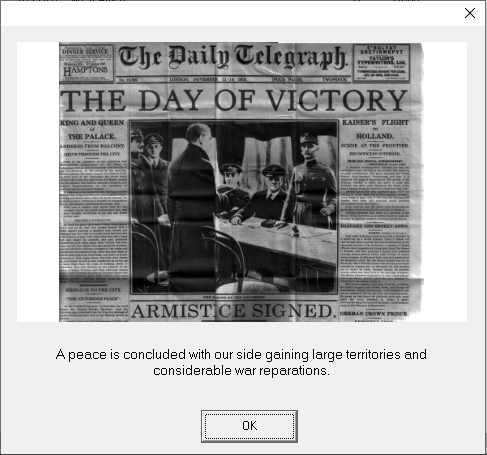
We get six points to spend on territory and/or reparations. I opt for two worthless (0-point) Pacific colonies, and leave the rest for more reparations.
November 1913
Frantically scrapping the most obsolete of our pre-dreadnoughts (the 22-knot Tridents will make either good aircraft carrier prototypes or good battle line filler, given that a line faster than 22 knots is still some time into the future, but all of the La Républiques get the axe), mothballing other ships, and halting construction of one of our new dreadnoughts, I manage to get the budget vaguely under control. I’ll still have to toggle the other dreadnought on and off.
December 1913
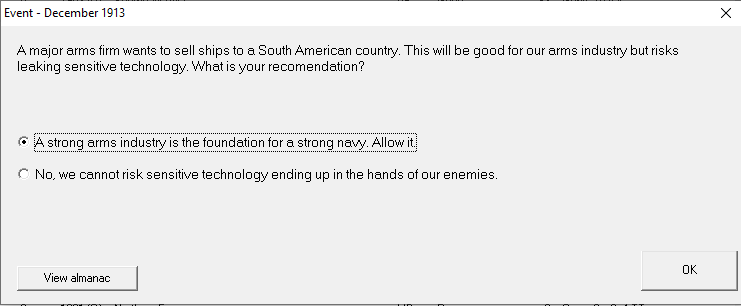
Sure thing (especially since the result is ‘more budget’).
French engineers have developed quality-0 14" guns, so it may be in the cards to scrap our second Requin altogether and prepare a new class with 14-inchers as our standard going forward. Our 12" guns are very good, but bigger, in this case, is always better.
March 1914
The budget is finally balanced enough for my liking, so I start a third ship in the new class of Lavoisier light cruisers and scrap the in-progress Colbert (the second Requin). When Requin herself is done, I’ll likely start on a new battleship—although you’ll have a chance to weigh in before then.
June 1914
The Naval Minister comes to me with the suggestion to build 15 new submarines. This time, I’m actually on board, and even better, the budget bump is enough to pay for 15 submarines and a quartet of new destroyers.
August 1914
Our alliance with Great Britain comes to an end. It was good while it lasted.
In other news, while scrolling through the technology list, I discovered that quadruple turrets are on the table now—a classic French design feature.
September 1914-January 1915, Update Wrap-Up
I appear to have lost my notes for these few months, so I’ll take care of everything all at once.
The only really interesting development in technology is improved quadruple turrets, which eliminate the reliability penalty and open the door to all sorts of interesting forward-main-armament ships.
Italy has developed flying boats, the first of the major powers to deploy military heavier-than-air aircraft.
Diplomacy
Tensions are low all around. We’re spying on the Austrians, the Italians, and the Americans (the latter only to see what the higher-tier powers are up to in terms of technology and design).
Technology

Here’s where things stand. According to the almanac, we’re in the middle: Germany, Britain, and the United States are ‘very advanced’; France is ‘average’, and Japan, Italy, and Austria-Hungary are ‘backward’. Our dock size, at 31,500, is a bit behind. When the submarines finish building in seven months, I think it’s time to invest in a few dock expansions in succession.
The Fleet
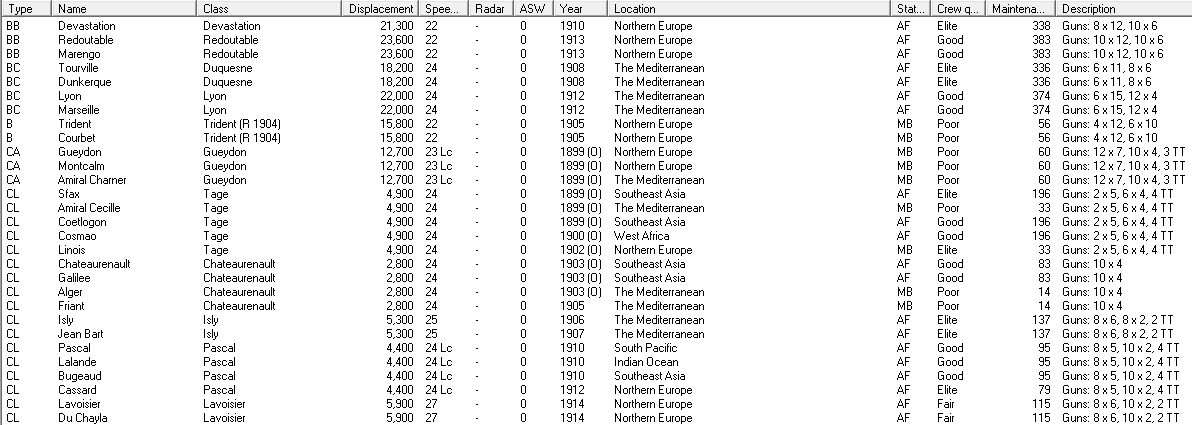
We have seven dreadnought-type ships: two of the early Duquesne-class battlecruisers, two Lyons (which ship the fleet’s heaviest guns), Devastation (our first dreadnought battleship), and two Redoubtables (our most recent dreadnought battleships).
We’ve retained two Tridents and three Gueydons, all of which will make fine aircraft carrier conversions when the time comes for that.
In addition to the pictured units, we have 27 destroyers of various types. The large majority are the obsolete Fauconneau class, which I’m tempted to retain as coastal protection ships—immediately putting them all into Trade Protection status when a war breaks out. They’re in mothballs currently.
As far as other destroyers go, we have three Francisques (also in mothballs, also something of a liability in wartime owing to their 28-knot speed), two Pistolets (31 knots), three Hallebards, and four Balistes. Some replacement destroyers are relatively high on the list. Our light cruiser force is also in the ‘large but obsolete’ category. (This was not unknown in the real world. Dreadnought construction sucks the air out of a great many other kinds of shipbuilding.)
Under construction, we have the Requin, a battleship with 12 12" guns and a 14" belt, the Rouen, a battlecruiser with 9 12" guns, 12" armor, and 27-knot speed, a pair of the new Lavoisier type of 27-knot, 6" gun light cruisers, four new 1,000-ton, 33-knot Harpon-class destroyers, and 15 submarines.
Prestige and Finance
We are currently in the very good graces of the French government, with 35 prestige. Our monthly budget is 16,883 funds, of which a mere 4,878 goes to maintenance, while 10,593 goes to new construction. Research (12%, 2,026), naval aircraft maintenance (256 for 16 airships), and spying round out the budget.
Plans
The Requin-type battleship on the ways is already a little dated. Since we have quality-0 14" guns now, my intention is to design a new 14" gun ship to take its place.
I’m inclined to try to keep two dreadnought ships under construction at all times, one battleship and one battlecruiser, but that may make it difficult to update our light forces. Should I sacrifice our big-ship construction program to bring the little ships up to date, or should I forge ahead in creating the best battle line millions of francs can buy?
Too, aircraft are appearing on the horizon, an ominous development for any navy which, across its entire roster, deploys zero anti-aircraft guns. Should we invest in carrier warfare as soon as we can, or stick out the dreadnought era as long as possible? Note that the balance of power between battleships and aircraft carriers shifts gradually over time—in the 1920s and early 1930s, it may be that the battleship remains king of the seas.
Anyway, that’s that for this week. Hopefully next week will be at the regularly scheduled time.
Great work. You taught the Germans a fine lesson in the art of naval warfare.
Do submarines play much of a role in full naval engagements or are they mostly only convoy raiders?
My natural thought is that if you’re going to be fighting Italy next (hopefully) you’re going to want something to counter their submarines so screen ships make a lot of sense.
I’d drop the battlecruiser line for a while and keep the battleships rolling off the line.
Invest heavily in research but not much in actual production. Dreadnoughts will rule the waves for now but aircraft will be necessary down the line. Also get some AA guns on the new screen ships.
dumb question - is this turn-based or quasi-RTS?
The strategic layer is one-month turns. The battle layer is kind of in between—it’s simulated in one-minute steps, and you can give orders in between any two steps.
(And sorry again for the immersion breaking discussion of game mechanics; I’m enjoying this thread) How many decisions/busywork do you have to make a turn in the rough spectrum between ‘early stages of a Civ game’ and Richard Berg’s Campaign for North Africa?
Much nearer the former end. Especially outside of wartime, a lot of months don’t have much at all to do—you’re waiting for new ships to finish, or for the right moment to build a new class.
One of the advantages to playing it in let’s-play fashion is that it makes me slow down. It can be tempting to hammer the ‘end turn’ button to get to a moment when something interesting is happening when I’m playing just for me.
I think you have a lot of active fleet ships for the current tension level. You could probably throw some more in reserve to get some more funds for modernization and light ship construction. You should probably either cheaply refit or scrap the obsolete ships in your inventory. Being obsolete imposes a combat penalty and makes it more expensive to maintain. One of your obsolete CLs is costing you more than 50% of a modern BB to maintain.
I’m also skeptical of the value of the legacy CA’s. If you’ve got say 4 years to the next fight, each of those is going to cost almost 3000, and then still be poor quality for a while.
Good point—I have a few of the much cheaper Chateaurenaults I can activate and send to Southeast Asia to fill the tonnage-on-station quota, so I’ll bring the Tages back and (probably) scrap a few of them, now that the Lavoisiers are coming online.
I’m keeping them around almost entirely because they’ll convert well to aircraft carriers, but I could probably stand to ditch one or two more of them, given that the Tridents are largely on hand for the same purpose.
